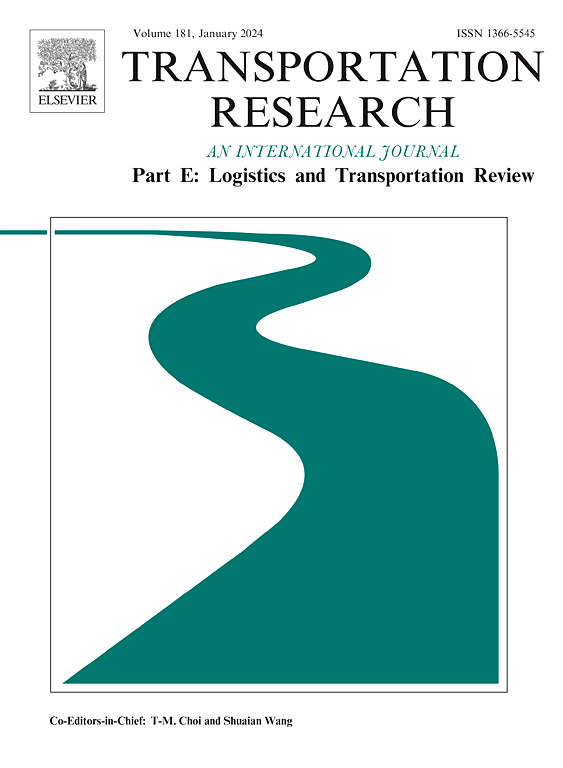Channel merchandising strategies considering customer behavior and supplier encroachment
IF 8.8
1区 工程技术
Q1 ECONOMICS
Transportation Research Part E-Logistics and Transportation Review
Pub Date : 2024-11-12
DOI:10.1016/j.tre.2024.103853
引用次数: 0
Abstract
This study investigates a two-echelon supply chain comprising a retailer, who considers whether to sell products as online-exclusive (products available only online) versus hybrid (products available both online and offline), and a supplier, who considers whether to encroach the online market. Given that there are more product varieties online than offline and competitive online marketplace, it remains unclear how retailers identify products that should be offered as hybrid versus online-exclusive. Comparing to online exclusive selling strategy, two key features of the hybrid selling strategy are captured: the demand expansion and profit margin effects. The demand expansion effect refers to the phenomenon where a retailer, transitioning from an online-exclusive approach to a hybrid approach, can expand market size by appealing to consumers who exclusively prefer offline purchases. Besides, the profit margin effect relates to how customer migration impacts retailer profits due to the disparity in unit product profit margins between online and offline channels. We reveal that the products with significant demand expansion effect should be offered as hybrid, and the hybrid selling strategy is efficient in preventing supply encroachment. However, even if the profit margin and demand expansion effect are positive, the products may be better to offer as online-exclusive. This is because, under the hybrid selling strategy, the supplier would charge a high wholesale price to squeeze the retailer’s profit. Consequently, the hybrid selling strategy in this circumstance intensifies the double marginalization effect, prompting the retailer not to opt for the hybrid selling strategy as a means to prevent supplier encroachment. Finally, the cross-selling effect, in which the customers buy some other products, strengthens the profit margin effect, and the results remain robust. Therefore, our study provides management insights that high-volume products may also be offered as online-exclusive, which challenges previous findings based on the long-tail phenomenon.
考虑客户行为和供应商侵蚀的渠道营销战略
本研究调查了一条由两个梯队组成的供应链,零售商和供应商分别考虑是否要将产品作为线上独家产品(仅在线上销售的产品)和混合产品(同时在线上和线下销售的产品)销售。鉴于线上产品种类比线下产品种类多,且线上市场竞争激烈,零售商如何确定哪些产品应作为混合型产品或线上独家产品销售仍不清楚。与在线独家销售策略相比,混合销售策略有两个主要特点:需求扩张效应和利润率效应。需求扩张效应是指零售商从线上独家销售方式过渡到混合销售方式时,可以通过吸引那些只喜欢线下购买的消费者来扩大市场规模。此外,利润率效应涉及顾客迁移如何影响零售商的利润,因为线上和线下渠道的单位产品利润率存在差异。我们发现,具有显著需求扩张效应的产品应作为混合产品提供,混合销售策略在防止供应蚕食方面是有效的。然而,即使利润率和需求扩张效应均为正值,这些产品也可能更适合以线上专供的方式发售。这是因为,在混合销售策略下,供应商会收取较高的批发价,以挤压零售商的利润。因此,在这种情况下,混合销售策略会加剧双重边缘化效应,促使零售商不选择混合销售策略作为防止供应商蚕食的手段。最后,顾客购买其他产品的交叉销售效应加强了利润率效应,结果依然稳健。因此,我们的研究为管理提供了启示,即大批量产品也可以作为在线独家产品提供,这对之前基于长尾现象的研究结果提出了挑战。
本文章由计算机程序翻译,如有差异,请以英文原文为准。
求助全文
约1分钟内获得全文
求助全文
来源期刊
CiteScore
16.20
自引率
16.00%
发文量
285
审稿时长
62 days
期刊介绍:
Transportation Research Part E: Logistics and Transportation Review is a reputable journal that publishes high-quality articles covering a wide range of topics in the field of logistics and transportation research. The journal welcomes submissions on various subjects, including transport economics, transport infrastructure and investment appraisal, evaluation of public policies related to transportation, empirical and analytical studies of logistics management practices and performance, logistics and operations models, and logistics and supply chain management.
Part E aims to provide informative and well-researched articles that contribute to the understanding and advancement of the field. The content of the journal is complementary to other prestigious journals in transportation research, such as Transportation Research Part A: Policy and Practice, Part B: Methodological, Part C: Emerging Technologies, Part D: Transport and Environment, and Part F: Traffic Psychology and Behaviour. Together, these journals form a comprehensive and cohesive reference for current research in transportation science.

 求助内容:
求助内容: 应助结果提醒方式:
应助结果提醒方式:


